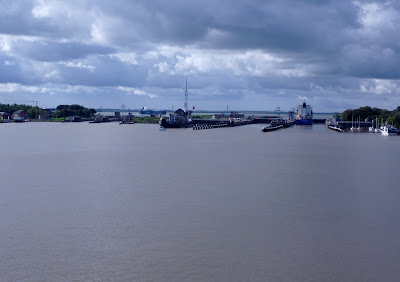After spending a day in Lübeck, the National Geographic Explorer took us north, and in the night we entered the Kiel Canal, a 98-kilometre (61 mile) canal connecting the Baltic and North Seas, once the busiest canal in the world.
After breakfast I dashed up for sightseeing, and soon saw this vessel passing us headed in the opposite direction, towards the Baltic.
We're catching up to a ship ahead. If the canal looks broad, that's because it was widened between 1907-1914 to accommodate the newest battleships of the Imperial German Navy.
Three of the omnipresent swans catch up to and pass us.
There's plenty of traffic behind us. It will only get busier.
One of the things which might have slowed the traffic is the Fischerhutte ferry. Our captain, Oliver Kruess, passed along the tidbit that, in Germany, if a ferry crosses a natural waterway, it's allowed to charge for the ferry ride. If the ferry crosses an artificial waterway, the ferry must be free. (There is no end to what you can learn by just hanging out on the bridge.)
But the major factor controlling traffic speed on the Kiel Canal is the width of ships. If there is a wide ship coming through, any other wide ships must wait in one of the pull-over zones until the one with right-of-way passes. I believe that's what is happening here.
Also, the heavy container ships tend to lift at the bow and dip at the stern when under way, the degree of tilt depending on the ship speed. The Kiel Canal is 11 meters deep, and the largest ships are allowed a 9½ meter draft, so there is little margin for a tilt.
The oncoming ship passed the wooden bollards, or tie-up points, in the pull-over and kept going.
Private vessels are allowed in the canal, of course, although it takes a bit of nerve.
Note the traffic signals along the canal, just as with railroads.
There seemed to be heavier traffic within the hour.
In the above photo we've just passed under the Grünental High Bridge, one of eleven road/railroad crossings of the canal. An earlier crossing, the Rendsburg High Bridge, has a transporter for pedestrian and auto traffic suspended from a high railway bridge. Here is a photo from the Wikimedia Commons.
Eventually we approached the locks on the western end of the canal, which empty into the estuary of the Elbe River. We will be entering the lock on the far right, which already has one ship in it, and there will be another beside us.
This area is highly developed, including wind turbines to take advantage of the winds arriving from the North Sea.
Many of our tribe are out to take in the action.
The Explorer eases into the lock.
The difference between the water level in the canal and in the sea is never great; there are locks only at either end of the canal. These locks create a stable water level that isn't subject to the tides. I engaged in a debate with a few fellow gawkers about whether the ship would be lowered or raised to meet the level of the Elbe estuary -- can you guess from the above photo? -- and lowered was the correct answer. (I was right.)
Meanwhile, once the Explorer was secure in the lock, the third ship began to slide in.
When finished, it was a close fit.
The operation of locks, almost anywhere in the world, always attracts a viewing gallery.
A ship in the adjoining lock left first. Then, our lock began to open. The Hanse Courage, in front, must go first.
And then we sailed out for Amsterdam, at which we would arrive tomorrow in a misty morning. This map (courtesy of the Lindblad web site) may help put our route thus far into perspective (click to enlarge).





















No comments:
Post a Comment
Comments may not appear immediately as they are moderated by the author to eliminate spam. Please, no commercial links!